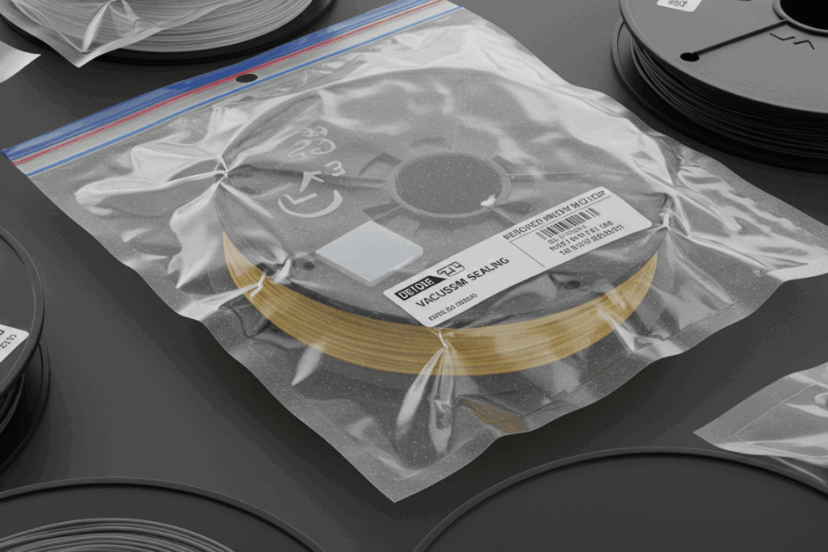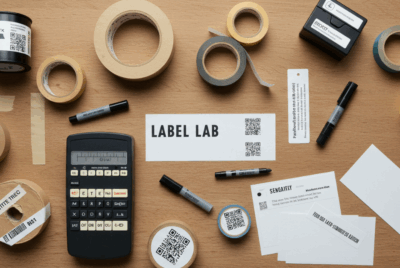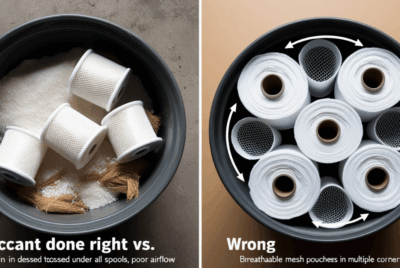How Does Vacuum-Sealing Protect Filament from Physical Damage During Storage?
Vacuum-sealing is an excellent method for storing 3D filament, not only because it protects the filament from moisture and air but also because it helps prevent physical damage during storage. Filament, especially sensitive types like Nylon, TPU, and ABS, can suffer from various forms of physical damage, such as deformation, abrasion, and tangling. Here’s how vacuum-sealing helps protect filament from such issues:
1. Prevents Spool Deformation
- How It Works: Vacuum-sealing removes excess air from the storage bag, which helps keep the filament spool securely in place. The vacuum pressure compresses the bag without exerting too much pressure on the spool itself.
- Why It Matters for Filament Storage: Without the protective seal of vacuum-sealing, spools can become deformed or crushed under external pressure. This is especially true for large spools or those that are stored improperly.
- How It Protects: The vacuum-sealed bag holds the spool in place, preventing it from being crushed or warped by external pressure. This maintains the integrity of the spool shape, allowing the filament to remain wound properly for easy use.
- Benefit: Keeps filament spools intact, maintaining their shape and ensuring that the filament feeds smoothly during printing without any issues like snapping or clumping.
2. Keeps Filament Tangle-Free
- How It Works: When filament is stored loosely, it can easily get tangled, which can lead to issues when feeding it into the printer. Vacuum-sealing compresses the bag and holds the spool in place, reducing the chances of tangling.
- Why It Matters for Filament Storage: Tangles can cause delays in your printing process, as they require untangling before you can use the filament. It can also lead to feed issues, where the filament gets stuck and doesn’t extrude properly.
- How It Protects: The vacuum-sealed bag keeps the filament spool tightly wound inside the bag. The air-tight seal prevents any loose filament from moving around, which minimizes the risk of tangling and ensures that the filament is in optimal condition when you need to use it.
- Benefit: Keeps filament organized and easy to handle, reducing the likelihood of tangling, which can slow down the printing process.
3. Protects from UV Damage
- How It Works: UV light can degrade filament over time, causing it to become brittle and weakened. Vacuum-sealing creates an airtight and light-blocking environment, reducing exposure to UV rays.
- Why It Matters for Filament Storage: Exposure to UV light can cause color fading and material degradation, especially for PLA, which is particularly sensitive to UV exposure.
- How It Protects: While vacuum-sealing itself doesn’t block all light, when combined with a dark storage environment, it helps shield the filament from harmful UV rays. The vacuum bag’s opacity blocks light from directly impacting the filament.
- Benefit: Protects filament from UV degradation, ensuring that it retains its quality and printability over time.
4. Shields Filament from Dust and Contaminants
- How It Works: Vacuum-sealing keeps the filament spool in a clean environment by completely sealing it off from outside elements like dust, dirt, or other contaminants that could affect the filament.
- Why It Matters for Filament Storage: Dust and contaminants can stick to the filament, leading to issues during printing, such as clogs in the extruder or poor adhesion between layers.
- How It Protects: Once vacuum-sealed, the filament is completely shielded from the environment. The airtight seal prevents dust and debris from entering, keeping the filament clean and free from contaminants.
- Benefit: Prevents extrusion issues and print failures caused by dust, dirt, or foreign particles adhering to the filament.
5. Prevents Physical Stress or Damage from External Pressure
- How It Works: Vacuum-sealing the filament spools helps protect them from external pressure that could cause the spools to become crushed or deformed.
- Why It Matters for Filament Storage: When stored loosely or improperly, spools can be subject to physical stress, especially if they are stacked or stored in environments with fluctuating pressure. This can cause the filament to bend, break, or lose its original shape.
- How It Protects: By removing air from the bag, the vacuum-sealed bag ensures that the spool is tightly secured and protected from physical stress. The seal also ensures that the spool is not subject to any fluctuating pressure from the environment.
- Benefit: Ensures that the filament spool stays in prime condition, avoiding issues like broken filament strands or distorted spools that could cause print problems.
6. Prevents Filament from Becoming Brittle or Weak
- How It Works: Exposure to moisture and oxygen can cause some filaments, like PLA, to become brittle over time. Vacuum-sealing removes the air from the bag, which helps preserve the filament’s strength and flexibility.
- Why It Matters for Filament Storage: Moisture absorption can significantly weaken filaments like Nylon and TPU, making them harder to work with. When stored improperly, moisture can cause filament to become soft or degraded and affect its printability.
- How It Protects: The vacuum-sealing process removes air and moisture, preventing the filament from absorbing environmental moisture. Combined with desiccants, it ensures that the filament remains dry and strong.
- Benefit: Helps maintain the flexibility and strength of the filament, ensuring that it remains ready to print without issues like brittleness or breakage.
7. Preserves Filament’s Original Shape
- How It Works: Filament spools are often wound tightly to ensure smooth, consistent feeding into the 3D printer. Improper storage methods or mishandling can cause the filament to lose its original shape, which may affect printing.
- Why It Matters for Filament Storage: When spools are not properly stored, they can become warped, causing the filament to lose its uniformity and making it difficult to feed it through the printer’s extruder. This can lead to clogs, uneven extrusion, or poor prints.
- How It Protects: Vacuum-sealing maintains the filament’s original wound shape, preventing any shifting or bending that could interfere with feeding the filament into the printer.
- Benefit: Ensures that the filament remains evenly wound and easy to use, preventing issues during printing.
Summary of How Vacuum-Sealing Protects Filament from Physical Damage:
- Prevents Spool Deformation: Keeps filament spools in their original shape, avoiding damage from external pressure.
- Keeps Filament Tangle-Free: Secures filament to prevent tangling, making it easier to feed into the printer.
- Protects from UV Damage: Blocks UV rays, preventing color fading and material degradation.
- Shields from Dust and Contaminants: Keeps filament clean and free from dust, dirt, and debris.
- Protects from Physical Stress: Eliminates external pressure that could cause spools to become deformed.
- Prevents Brittleness: Keeps filament dry and strong by reducing exposure to moisture and air.
- Preserves Original Shape: Ensures filament remains properly wound and easy to use.
Conclusion:
Vacuum-sealing is an effective method for protecting filament from physical damage during storage. It not only provides moisture protection but also preserves the filament’s shape, strength, and cleanliness, ensuring that it remains in optimal condition for printing. By following proper vacuum-sealing techniques, you can keep your filament spools free from deformation, tangling, and physical stress, ultimately improving the quality and longevity of your 3D printing materials.




